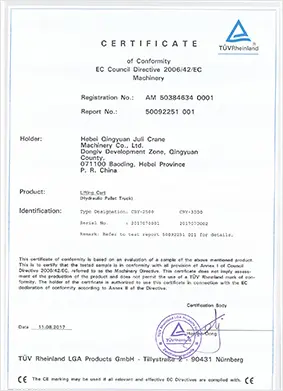


The Rise of Semi-Powered Pallet Trucks Revolutionizing Material Handling
In the fast-paced world of logistics and warehousing, efficiency and productivity are paramount. As industries strive to optimize their operations, the introduction of innovative equipment has transformed the way goods are handled and transported. One such innovation is the semi-powered pallet truck, a versatile tool that combines the functionality of manual pallet jacks with the benefits of powered assistance. This article explores the features, advantages, and impact of semi-powered pallet trucks in modern material handling.
Understanding Semi-Powered Pallet Trucks
Semi-powered pallet trucks are designed to streamline the process of moving heavy loads in warehouses and distribution centers. These trucks typically feature a manual steering mechanism combined with an electric lifting system. This hybrid functionality allows operators to manually maneuver the truck while utilizing powered assistance to lift and lower pallets, significantly reducing the physical strain on workers.
The design of semi-powered pallet trucks varies, but they generally share common elements such as a robust frame, ergonomic handles, and a battery-operated lifting system. Many models are also equipped with safety features such as emergency stop buttons, horn alerts, and stability controls, ensuring both the operator's safety and the protection of the cargo being transported.
Benefits of Semi-Powered Pallet Trucks
1. Enhanced Efficiency The hybrid lifting mechanism allows operators to handle heavier loads with ease. This efficiency translates to faster loading and unloading times, which is crucial in meeting tight deadlines and increasing overall productivity.
2. Reduced Physical Strain With the powered lifting feature, workers no longer have to exert excessive force to lift heavy pallets. This significantly lowers the risk of injury related to manual handling, contributing to a safer work environment.

3. Cost-Effectiveness Investing in semi-powered pallet trucks can yield significant savings. By improving workflow and reducing the likelihood of workplace injuries, businesses can minimize operational costs related to labor and potential compensation claims.
4. User-Friendly Design Most semi-powered pallet trucks are designed for ease of use, requiring minimal training for operators. This user-friendly approach promotes a smoother integration into existing workflows and minimizes productivity loss during training periods.
5. Versatility These trucks are adaptable to various environments, from cramped aisles in warehouses to expansive loading docks. Their ability to navigate tight spaces and transport heavy loads makes them invaluable in diverse operational settings.
Impact on Material Handling
The introduction of semi-powered pallet trucks has revolutionized material handling practices. As more businesses adopt this technology, the overall efficiency of logistics operations improves. Furthermore, the emphasis on worker safety has become a focal point for many organizations, and semi-powered pallet trucks contribute significantly to reducing the physical demands placed on employees.
In an era where e-commerce and global trade continue to rise, the need for effective and innovative material handling solutions is more critical than ever. Semi-powered pallet trucks stand out as an optimal choice for businesses aiming to enhance their operations while prioritizing the well-being of their workforce.
Conclusion
The semi-powered pallet truck represents a significant advancement in the domain of material handling. By bridging the gap between manual and powered equipment, it offers a practical solution for modern logistics challenges. With benefits ranging from increased efficiency and reduced physical strain to cost savings and improved safety, these trucks are set to play a pivotal role in the future of warehousing and distribution. As businesses continue to seek innovative solutions to enhance productivity, the semi-powered pallet truck is certainly a key player in the ongoing evolution of the material handling landscape.



